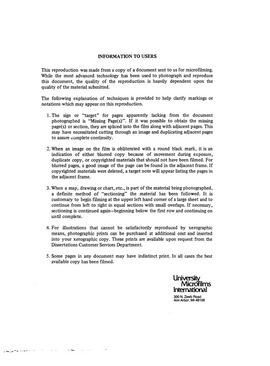| dc.contributor.author | Chance, Edward Wayne, | en_US |
| dc.date.accessioned | 2013-08-16T12:29:22Z | |
| dc.date.available | 2013-08-16T12:29:22Z | |
| dc.date.issued | 1985 | en_US |
| dc.identifier.uri | https://hdl.handle.net/11244/5349 | |
| dc.description.abstract | This historical/descriptive work provides an overview of nine major discipline programs that have been developed since 1960 to address education's increasing concern for the maintenance of a classroom environment that is conducive to learning. The programs reviewed after a historical overview of discipline included: (1) Jacob Kounin and Group Management; (2) Redl and Wattenberg's Approach to Discipline; (3) the Ginott Model of Discipline; (4) Dreikurs' Model of Mistaken Goals; (5) the L.E.A.S.T. Approach to Discipline; (6) Daniel Duke's Systematic Management Plan for School Discipline; (7) Thomas Gordon's Teacher Effectiveness Training; (8) William Glasser and Reality Therapy; and, (9) Lee Canter's Assertive Discipline. Each discipline method was reviewed as to total program, techniques, and procedures. Individually, the programs were evaluated as to whether or not the program emphasis was on the individual or group. Each was also evaluated as to its position regarding class meetings, rule setting, punishment, and selected communication styles. | en_US |
| dc.description.abstract | In developing a synthesis of the reviewed programs, it appears that a successful teacher with relatively few classroom discipline problems should possess certain attributes and characteristics. One should possess a thorough knowledge of subject matter as well as being well organized and aware of everything that takes place in the classroom. It addition, the teacher should be cognizant of the group dynamics and processes that daily take place in addition to the individual needs of each student. Students should be addressed using appropriate I-messages, and an exhibited concern for them should be evident. It would behoove the individual teacher to allow the students some degree of input into class procedures or, at the very least, utilize class meetings to achieve the objective of increasing communication and class awareness. | en_US |
| dc.description.abstract | No one program was judged to be better than the others, but it was concluded that it would be pertinent to utilize those aspects of each program that would be most relevant to the individual educator's needs or situation. | en_US |
| dc.format.extent | viii, 246 leaves ; | en_US |
| dc.publisher | The University of Oklahoma. | en_US |
| dc.subject | Education, Administration. | en_US |
| dc.subject | Public schools. | en_US |
| dc.subject | Discipline of children. | en_US |
| dc.title | An overview of major discipline programs in public schools since 1960 / | en_US |
| dc.type | Thesis | en_US |
| dc.thesis.degree | Ph.D. | en_US |
| dc.note | Source: Dissertation Abstracts International, Volume: 46-08, Section: A, page: 2140. | en_US |
| ou.identifier | (UMI)AAI8524071 | en_US |
| ou.group | Jeannine Rainbolt College of Education | |
